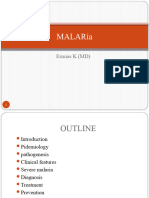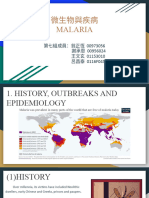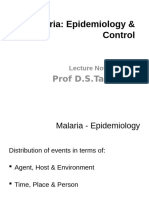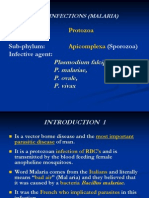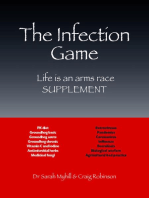The Malarias:: Plasmodium Falciparum Plasmodium Vivax Plasmodium Malariae Plasmodium Ovale
The Malarias:: Plasmodium Falciparum Plasmodium Vivax Plasmodium Malariae Plasmodium Ovale
Uploaded by
chandragabriellaCopyright:
Available Formats
The Malarias:: Plasmodium Falciparum Plasmodium Vivax Plasmodium Malariae Plasmodium Ovale
The Malarias:: Plasmodium Falciparum Plasmodium Vivax Plasmodium Malariae Plasmodium Ovale
Uploaded by
chandragabriellaOriginal Title
Copyright
Available Formats
Share this document
Did you find this document useful?
Is this content inappropriate?
Copyright:
Available Formats
The Malarias:: Plasmodium Falciparum Plasmodium Vivax Plasmodium Malariae Plasmodium Ovale
The Malarias:: Plasmodium Falciparum Plasmodium Vivax Plasmodium Malariae Plasmodium Ovale
Uploaded by
chandragabriellaCopyright:
Available Formats
1
The Malarias:
Plasmodium falciparum
Plasmodium vivax
Plasmodium malariae
Plasmodium ovale
Distribution of Plasmodium falciparum
2
Distribution Of Plasmodium vivax
3
Global Risk By Country-Proportionality Plot
P. falciparum
P. vivax
3 million deaths/yr. 1 million in Africa, 3 million deaths/yr. 1 million in Africa,
mostly children below the age of 5 mostly children below the age of 5
4
Watersheds of the African Continent
Mosquitoes are aquatic insects
Population
density
World Situation
Approx. 2 billion infections/yr
Economic and social development reduced
27% of the world lies within the malaria
transmission zone
New unstable transmission area: Bangladesh
Impact of malaria on population change ?
5
MalariousArea of the United States
1934-5
6
Adult Anopheles dirus taking a blood
meal from one of the authors (RWG)
Plasmodium falciparum
7
Plasmodium vivax
Plasmodium ovale
8
Plasmodium malariae
9
Adult Anopheles dirus taking a blood
meal from one of the authors (RWG)
10
Ex-flagellation of the microgametocyte
of a malaria parasite in mosquito stomach
Portion of an infected mosquito stomach.
Note numerous oocystson outer wall.
11
Sporozoitesof malaria in infected
mosquito stomach preparation
SEM Light micrograph
1m
Photo: Photini Sinnis
Entry Of Sporozoites Into Parenchymal Cells Of The Liver
From: Ute Frevert
NYU School of Medicine
12
Exo-erythrocyticstages of malaria
in liver parenchymal cell
Plasmodium Anatomy
13
Transmission EM of merozoite entering a red cell.
Note points of attachment
Mechanisms of Red Cell Invasion
By Plasmodium
14
Ring stage
Erythrocyticstages of malaria:
All infections begin with the ring stage
regardless of the the species
Pathogenesis
Destruction of erythrocytes; anemia
Liberation of parasite and erythrocyte material
into circulation
Host reaction to these events (multiple organ
system disease, acidosisin acute disease)
P. falciparum has unique sequestration in micro-
circulation of vital organs interfering with flow
and tissue metabolism
Long-term effects of repeated infections - learning
deficit, spontaneous abortion, reduced growth
rates; all may be due to prolonged acidosis
15
Clinical Signs & Symptoms
Fever, paroxysms of shaking chills
Tertian vsquartanfever pattern
Symptoms when other organs involved
Hemolysis: icterus, jaundice, enlarged
spleen
16
Susceptibility to malaria, antibody production, and lethality.
Transmission EM: RBC infected with P. falciparum
Knobs of histidine-rich protein.
Points of attachment to endothelial cell
N =Nucleus; F =food vacuole
17
Cerebral malaria: experimental infection in monkey
stain: tissue Giemsa
Diagnosis
18
Plasmodium falciparum
In peripheral
blood: 1-15; 27-30
Not in peripheral
blood: 16-26
Electron micrograph of knobs
Atomic force microscopy of knobs
Normal RBC
Stages of P. falciparum with knobs
In situ RBCs
with P. falciparum
19
Plasmodium vivax
Infected RBCslarger
than non-infected RBCs,
Schffnersdots
Plasmodium ovale
Same as P. vivax
20
Plasmodium malariae
Plasmodium vivax
Infected RBCssame size as non-infected RBCs,
No Schffnersdots
Infected RBCsenlarged
Treatment
Type of malaria
Knowledge of regional resistance
Severity of illness (oral vsintravenous)
Age of patient
21
Distribution of Plasmodium falciparum
Drug-resistant Malaria
Red - chloroquine resistant
Green - chloroquine sensitive
Black - chloroquine and mefloquine resistant
22
Mode of Action of Chloroquine
And Mechanisms of Drug Resistance
Stacking enzyme
Parasite toxic waste dump: hemozoin(HZ)
Chloroquine
The parasite uses the protein portion of hemoglobin
and discards the hememoiety as hemozoin.
Mefloquine
Chloroquine
Quinine
Drugs Of Choice:
A. Parent Compound
B. Older Derivative: extensive resistance
C. Newer Derivative
D. Drugs of choice
Atovaquon Proguanil
23
PABA (Para-aminobenzoic Acid) Pteridine +
Sulfonamides / Dapsone
Pyrimethamine, Proguanil Dihydrofolate reductase
Folic acid
Dihydrofolic acid
Tetrahydrofolic acid
Dihydropteroate
Synthetase
Treatment: Anti-Folates
Artemesinin
Artemisia sp.
24
Shortage of
Shortage of
artemesinin
artemesinin
:
:
one crop/year
one crop/year
Spraying residual DDT
25
Antimalarial Prophylaxis
North American travelers lack immunity
to malaria
Risk of acquiring malaria depends on rural travel,
altitude, season of travel.
Highest risk in low lying areas during rainy season
Personal protection measures against mosquitoes
as important as drugs.
Insect repellants, mosquito nets, clothing covering
body
Antimalarial drugs do not prevent infection and
initial liver stage
Conclusion of article: 20% of the children harbor 80% of the Conclusion of article: 20% of the children harbor 80% of the
infections because they are bitten more often. infections because they are bitten more often.
Q: Since mosquitoes home in on us via CO Q: Since mosquitoes home in on us via CO
2 2
, body temperature , body temperature
and perhaps other odors, is there a genetics controlling our and perhaps other odors, is there a genetics controlling our
susceptibility to being bitten? susceptibility to being bitten?
26
Types of Preventive Measures: Drugs
Prophylaxis with medications based on knowledge
of geographic resistance patterns
Mefloquine, Doxycycline, Atovaquone-Proguanil
Self treatment: Fansidar, Quinine
Combination of both: Chloroquine
chemoprophylaxis with standby Rx (Not
Recommended!)
MDR resistance a problem in Thailand, Cambodia
and Increasingly E. Africa
27
Future Research
? Vaccine; none yet but many being tested
New and Better drugs
Safety in Children
Safety in Pregnant Women
? 1 dose
A major reason why there is still no vaccine
28
1,500 languages! 1,500 antigenic strains of P. falciparum!
You might also like
- Epidemiology Prevention & Control of Malaria: Dr. Neha Tyagi Assistant Professor Department of Community MedicineDocument29 pagesEpidemiology Prevention & Control of Malaria: Dr. Neha Tyagi Assistant Professor Department of Community MedicineShashi TyagiNo ratings yet
- Malaria - 2024Document29 pagesMalaria - 2024drrayyannabi03No ratings yet
- Epidemiology & Control of Tropical DiseaseDocument38 pagesEpidemiology & Control of Tropical DiseaseMazinNo ratings yet
- Malaria MettyDocument13 pagesMalaria MettySiti Qomariah AnisaNo ratings yet
- Malaria LectureDocument32 pagesMalaria LectureNwosu Ogbonna Gabriel100% (1)
- Malaria HODocument45 pagesMalaria HOnitsuhNo ratings yet
- MalariaDocument50 pagesMalariahalgarprashantNo ratings yet
- MalariaDocument52 pagesMalariaSudeep YadavNo ratings yet
- GROUP A1 (A) Topic 5Document37 pagesGROUP A1 (A) Topic 5KhaiNo ratings yet
- 4 MalariaDocument75 pages4 Malariahailu henockNo ratings yet
- Malaria in PregnancyDocument8 pagesMalaria in PregnancyBright KumwendaNo ratings yet
- Plasmodium SpeciesDocument39 pagesPlasmodium SpeciesTejkumarigurungNo ratings yet
- Malaria: by Tadele Kegnu (MD, MSC.)Document57 pagesMalaria: by Tadele Kegnu (MD, MSC.)semere demissieNo ratings yet
- MALARIA (Autosaved)Document16 pagesMALARIA (Autosaved)Mpanso Ahmad AlhijjNo ratings yet
- Muskan Agarwal ?Document47 pagesMuskan Agarwal ?Ankit KumarNo ratings yet
- Malaria & Typhoid UpdatedDocument39 pagesMalaria & Typhoid Updatedminahil qadeerNo ratings yet
- Malaria: DR Sulaiman Conteh Medical StudentsDocument36 pagesMalaria: DR Sulaiman Conteh Medical StudentsAbubakar JallohNo ratings yet
- Malaria Parasite (Plasmodium) BiochemistryDocument21 pagesMalaria Parasite (Plasmodium) BiochemistryAbiola NerdNo ratings yet
- Arthropod Borne Infections - MHA (12 Files Merged)Document377 pagesArthropod Borne Infections - MHA (12 Files Merged)MariaNo ratings yet
- 04 - Malaria BestDocument57 pages04 - Malaria BestKedir AhmedNo ratings yet
- Medicine Lec.12 - Protozoal InfectionDocument60 pagesMedicine Lec.12 - Protozoal Infection7fefdfbea1No ratings yet
- MalariaDocument12 pagesMalariaDevansh AskarNo ratings yet
- MalariDocument36 pagesMalariUmashankar SharmaNo ratings yet
- Malaria: Dr. Shree Narayan Yadav Internal Medicine Resident NamsDocument40 pagesMalaria: Dr. Shree Narayan Yadav Internal Medicine Resident Namsasyanadhikary18100% (1)
- Malaria Trans EditedDocument4 pagesMalaria Trans EditedSven OrdanzaNo ratings yet
- MalariaDocument49 pagesMalaria2253010837No ratings yet
- 微生物與疾病Document22 pages微生物與疾病super longhairNo ratings yet
- Presentation On Malaria (Autosaved)Document21 pagesPresentation On Malaria (Autosaved)zoeakatNo ratings yet
- Malaria FalciparumDocument35 pagesMalaria FalciparumAboubakar Moalim Mahad moh'dNo ratings yet
- Malaria 1. Who and How?: P. Falciparum P. VivaxDocument6 pagesMalaria 1. Who and How?: P. Falciparum P. VivaxAdriana del RioNo ratings yet
- Haemoparasite-Malaria A Detailed StudyDocument23 pagesHaemoparasite-Malaria A Detailed Studybernard allan mabantoNo ratings yet
- Referat Malaria InovDocument29 pagesReferat Malaria InovAssifa RidzkiNo ratings yet
- Case 3.2 (Malaria) : Arwa Hussain Al-Onayzan. 215007943. 66Document24 pagesCase 3.2 (Malaria) : Arwa Hussain Al-Onayzan. 215007943. 66Danial HassanNo ratings yet
- (Sfuchas Lecture) Malaria Epidemiology & Control Nov. 2024Document37 pages(Sfuchas Lecture) Malaria Epidemiology & Control Nov. 2024felicianalphonce196No ratings yet
- LeishmaniaFilaria Part 1Document45 pagesLeishmaniaFilaria Part 1YS Nate100% (1)
- Bio Investigatory ProjectDocument25 pagesBio Investigatory ProjectVijayNo ratings yet
- Malaria by Dr. A.M IyagbaDocument51 pagesMalaria by Dr. A.M IyagbaDr. Amb. Monday ZaccheausNo ratings yet
- Phylum: Sub-Phylum: (Sporozoa) Infective Agent:: Protozoa ApicomplexaDocument42 pagesPhylum: Sub-Phylum: (Sporozoa) Infective Agent:: Protozoa Apicomplexacharway_2000No ratings yet
- CDC Part 2Document297 pagesCDC Part 2fdamissieNo ratings yet
- Malariappt 110313053826 Phpapp01Document12 pagesMalariappt 110313053826 Phpapp01spiderind2No ratings yet
- MalariaDocument24 pagesMalariadhanj1921No ratings yet
- Malaria Is A MosquitoDocument2 pagesMalaria Is A MosquitoReynante T. BitasNo ratings yet
- Disease Caused by ProtozoansDocument21 pagesDisease Caused by ProtozoansBrijesh KumarNo ratings yet
- Current Trends in The Management of MalariaDocument41 pagesCurrent Trends in The Management of Malariaghr9cjy5npNo ratings yet
- MalariaDocument3 pagesMalariaamahapatroNo ratings yet
- Apicomplexa 2023Document39 pagesApicomplexa 2023Ming YanNo ratings yet
- College of Veterinary and Animal Sciences, Parbhani Department of Veterinary PathologyDocument13 pagesCollege of Veterinary and Animal Sciences, Parbhani Department of Veterinary Pathologydahiphale1No ratings yet
- MalariaDocument12 pagesMalariasaxebe7427No ratings yet
- 10.1 Infectious DiseasesDocument80 pages10.1 Infectious Diseasesnie20060301No ratings yet
- E MalariaDocument40 pagesE MalariaUmair AliNo ratings yet
- Malaria Is A Parasitic Disease That Involves High Fevers, Shaking Chills, Flu-Like Symptoms, and AnemiaDocument6 pagesMalaria Is A Parasitic Disease That Involves High Fevers, Shaking Chills, Flu-Like Symptoms, and AnemiaMarrylane GamisNo ratings yet
- Malaria: Michelle Carandang-Cuvin, M.D. FPPS, Fpidsp Pediatric Infectious Disease ConsultantDocument77 pagesMalaria: Michelle Carandang-Cuvin, M.D. FPPS, Fpidsp Pediatric Infectious Disease ConsultantHanako AranillaNo ratings yet
- Introduction To MalariaDocument28 pagesIntroduction To MalariaajanawNo ratings yet
- One Day Workshop Yums: - Tissue and Blood Protozoan DiseasesDocument47 pagesOne Day Workshop Yums: - Tissue and Blood Protozoan DiseasesAndre KerenNo ratings yet
- Antimalarial Drugs 1ADocument49 pagesAntimalarial Drugs 1Apallavi DiwareNo ratings yet
- Protozoa. Sporozoa. Haemosporidia (The Malaria Parasites)Document22 pagesProtozoa. Sporozoa. Haemosporidia (The Malaria Parasites)Sharan MurugaboopathyNo ratings yet
- MalariaDocument11 pagesMalariaGaro AllieNo ratings yet
- Malaria: Malariae Is Found in Most Areas, But Is Relatively Uncommon Outside AfricaDocument6 pagesMalaria: Malariae Is Found in Most Areas, But Is Relatively Uncommon Outside AfricaGweta SaldanaNo ratings yet
- The Infection Game Supplement: new infections, retroviruses and pandemicsFrom EverandThe Infection Game Supplement: new infections, retroviruses and pandemicsNo ratings yet



















